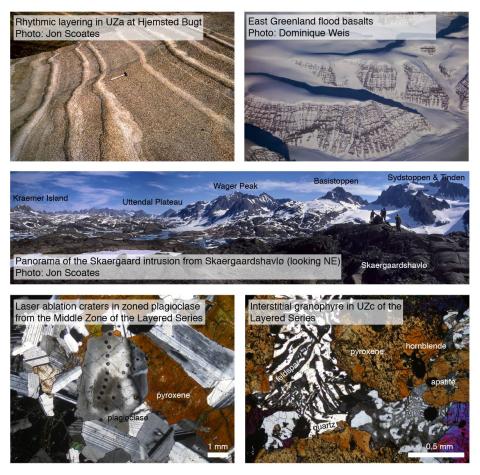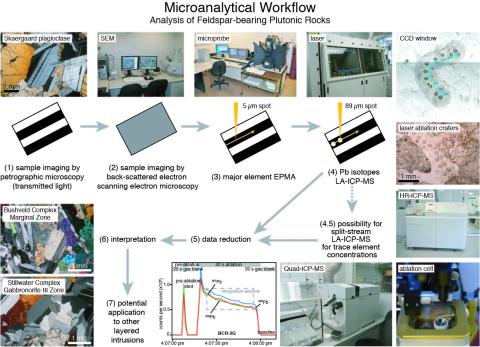Researchers: June O. Cho, James S. Scoates, Dominique Weis, Marghaleray Amini
What question or problem are you trying to address?
The Skaergaard intrusion represents the archetypal example of a closed-system layered intrusion (Wager and Brown, 1968). It has long held a position of importance in igneous petrology, and studies of this remarkably preserved and stratigraphically complete intrusion have profoundly influenced our understanding of many fundamental petrologic concepts (Fig. 1). Despite the breadth and depth of work on this intrusion (e.g., Holness et al., 2017, and references therein), there remain a number of knowledge gaps and ongoing debates.

In this study, we used an integrated approach that involves the microanalysis of feldspar, the most abundant mineral in the Skaergaard intrusion (Cho, 2019). The integration of micron-scale observations from electron microprobe analysis and LA-ICP-MS are used to examine and address:
- The differentiation processes preserved in primocryst and interstitial feldspar;
- The validity of the closed-system model for crystallization;
- The genetic link between the Skaergaard intrusion and the overlying East Greenland flood basalts.
Why is this research important?
The Skaergaard intrusion is part of the North Atlantic Igneous Province, a large igneous province associated with break-up magmatism and the opening of the North Atlantic Ocean. A major theme of research into the petrogenesis of continental systems has been to resolve the link, if any, that exists between erupted flood basalts and layered intrusions (e.g., Andreasen et al., 2004; Nielsen et al., 2019). These magmas (molten rock) have undergone various stages and extents of crystal fractionation and crustal assimilation, and the rocks in layered intrusions are cumulates consisting of minerals that crystallized and accumulated from magma. Examining all components (layered intrusions, sills, flood basalts) is important for understanding the petrogenesis of layered intrusions and their role in these major crust-building episodes. The combined microanalytical results of feldspars provides new insights into the crystallization history of the Skaergaard intrusion and the extent of contamination of mantle-derived melts in the crust during flood basalt magmatism.
How will you accomplish your research?
The project involved aspects of method development, including set-up of the split-stream LA-ICP-MS system at PCIGR to simultaneously measure lead (Pb) isotope ratios and trace element concentrations. This method allows for rapid, accurate, and precise measurements at micrometre-scale spatial solutions, with the ability to target specific locations of mineral grains (i.e., core, rim) (Fig. 2).

The analytical set-up used an Applied Spectra Resonetics RESOlution M-50-LR ArF excimer laser ablation system connected to a Nu Instruments AttoM double-focusing, single-collector, high-resolution magnetic sector ICP-MS (for measuring Pb isotope ratios) and an Agilent 7700x quadrupole ICP-MS (for measuring trace element concentrations). We tested a series of physical configurations and instrumental settings to maximize precision and accuracy to produce results with geologically meaningful uncertainties.
What do you hope to find or what are your main findings?
The combined microanalytical results provided new insights on magma chamber processes (mush conditions, crustal contamination), late-stage magmatic processes (silicate liquid immiscibility, exsolution, reaction with residual liquid), and secondary modification (hydrothermal alteration, albitization of feldspar).
The major element results (>2600 analyses) span nearly the entire range of possible ternary feldspar compositions. Intermediate-composition plagioclase primocrysts with different zoning patterns track fractionation. Granophyres, which may represent crystallized silicon-rich immiscible melts, contain finely intergrown oligoclase and alkali feldspar that originally crystallized as a single albite-rich alkali feldspar prior to exsolution. Secondary albite represents alteration products formed as a result of meteoric fluid circulation and albitization.
The Pb isotope results (>750 analyses) indicate that most of the Skaergaard intrusion has the same Pb isotope composition within analytical uncertainty, confirming closed-system differentiation. Only minor incorporation of crustal materials (<1%) is detectable in two samples from the outermost margin. The Pb isotope composition of the parental Skaergaard magma as represented by the average Skaergaard composition, is less radiogenic than most of the flood basalts, linking the Skaergaard intrusion to the eruption of the lowermost East Greenland flood basalts. The results demonstrate the power of measuring Pb isotopes in feldspars by LA-ICP-MS directly in thin section as even the smallest degrees of crustal contamination can be detected.
References
Andreasen, R., Peate, D.W. and Brooks, C.K. 2004. Magma plumbing systems in large igneous provinces: inferences from cyclical variations in Palaeogene East Greenland basalts. Contributions to Mineralogy and Petrology, 147: 438–452.
Cho, J.O. 2019. A microanalytical investigation of feldspars in the Skaergaard intrusion, East Greenland: Ternary feldspar compositional relations and lead isotopic geochemistry. Unpublished M.Sc. thesis, University of British Columbia, Canada. 407 pp.
Holness, M.B., Nielsen, T.D. and Tegner, C. 2017. The Skaergaard intrusion of East Greenland: Paradigms, problems and new perspectives. Elements, 13: 391–396.
Nielsen, T.F.D., Brooks, C.K. and Keiding, J.K. 2019. Bulk liquid for the Skaergaard intrusion and its PGE-Au mineralization: Composition, correlation, liquid line of descent, and timing of sulphide saturation and silicate–silicate immiscibility. Journal of Petrology, 60: 1853–1880.
Wager, L.R. and Brown, G.M. 1968. Layered Igneous Rocks. W.H. Freeman & Co., San Francisco. 588 pp.